So many books this month, and this time, we've got all superlatives. Check out the second June Galactoscope!
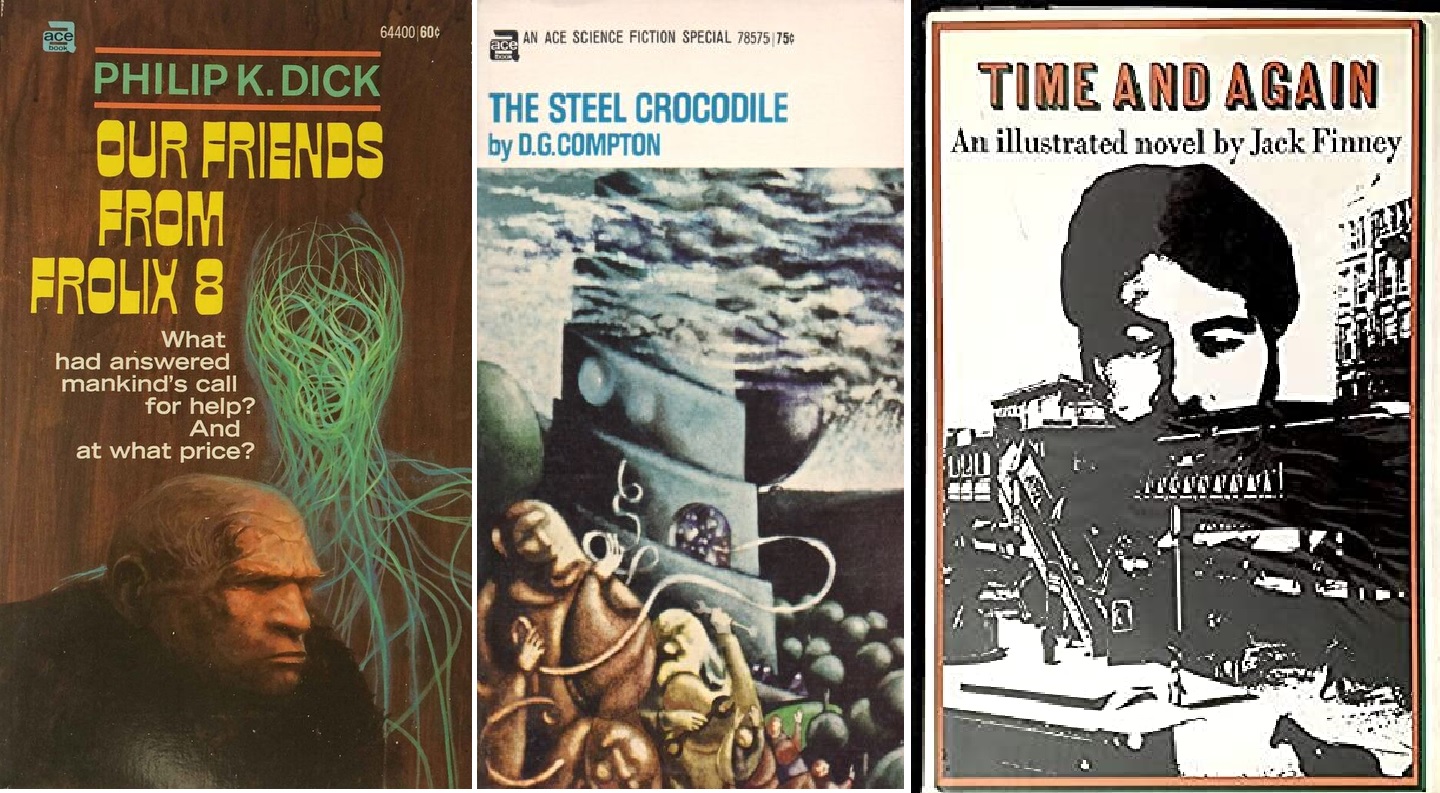
Continue reading [June 17, 1970] Time and Again (June Galactoscope Part Two!)
So many books this month, and this time, we've got all superlatives. Check out the second June Galactoscope!

Continue reading [June 17, 1970] Time and Again (June Galactoscope Part Two!)
 by Jason Sacks
by Jason Sacks
Before you start reading this essay, let me warn you: I will be discussing major plot details from the latest Hollywood blockbuster, Beneath the Planet of the Apes. This will include the movie’s conclusion. For that matter, this article also ruins the ending of the original film. So be warned in case you haven't yet been to your local multiplex to see these in double-feature. On the other hand, you may well wish to go in with your eyes wide open… because Beneath the Planet of the Apes is both a fascinating continuation and a jaw-dropping pivot. 
Continue reading [June 8, 1970] Beneath the Planet of the… Mutants? (Not Apes)

by David Levinson
The Matter of Britain
When I was a boy, someone gave me Howard Pyle’s The Story of King Arthur and His Knights. For many years, I would occasionally look at the pictures, but never bothered to read it. I finally did when I was 14 or 15, and I was hooked.
All things Arthur became an obsession. I wasn’t satisfied with modern retellings and hunted long and hard for a decent modernization of Sir Thomas Malory. That led to Continental poets who wrote about Arthur, like Wolfram von Eschenbach and Chrétien de Troyes. Once I had access to a university library, I discovered the Welsh legends and then the early Medieval and Dark Age historians who mentioned him by name or indirectly. Suddenly, my obsession with King Arthur merged with my obsession with ancient history, and I was off again.
Eventually my ardor cooled due to a lack of new things to learn and the demands of being an adult, but for 15 or 20 years I lived and breathed this stuff. And now, Mary Stewart has brought it all back.
The Crystal Cave, by Mary Stewart

Continue reading [May 2, 1970] Gaudy Shadows in the Crystal Cave (May 1970 Galactoscope)

by Jason Sacks
1970 has been a bit of a tough year for us in Seattle.
Our major local company, Boeing, has suffered the worst year in its history. The Boeing Bust keeps continuing, as the 1969 layoffs have grown into a full-scale decimation. Unemployment is up around 10% now, the worst since the Great Depression, and my family and I are starting to panic. Of course, the fall of Boeing hits many other local industries, so places like restaurants, bookstores and movie theatres are especially hard hit by this. And many of my friends have either moved or contemplated moving – even if they will lose money on their fancy $50,000 homes in the suburbs.

To make matters worse, we’ve also lost our pro baseball team, which I wrote about last summer. The Seattle Pilots premiered in ’69, in a minor league park and with the worst uniforms in the Majors. But after just one season, the team is gone—relocated to Milwaukee, of all places, leaving behind a community that embraced them despite the challenges. For my friends and family, it wasn’t just about losing a baseball team; it was about losing a piece of the city’s identity. Just as we gained a second sports team to join our beloved SuperSonics, they were wrenched away from us.
Their home park, Sick’s Stadium, had its flaws. But it was our flawed park. Fans showed up, hopeful that the Pilots would grow into something more. Their financial struggles were well-known, reported faithfully in our local Times and P-I, but few expected the team to vanish overnight. When the sale was finalized on April 1, 1970, it felt like an April Fools’ joke—except it was real. The Pilots were rebranded as the Brewers, and we were left without a Major League Baseball team.

In fact, the Pilots trained in Spring Training as the Pilots before a chaotic moment as they traveled north from Arizona. Equipment trucks were redirected from highway pay phones, as the team learned they would be playing in Wisconsin rather than Washington. The new Brewers played their first game this week at Milwaukee County Stadium. The Pilots are no more.
Of course, the lawyers are getting involved and we may get a team in the future – but a city that deserved some good news has received some devastating news instead. We are like mariners without a destination as far as baseball goes.
And in the midst of all that frustration comes a film that’s ultimately about mankind’s frustrating hubris.
Colossus: The Forbin Project, adapted from the 1966 novel, is claustrophobic, unsettling, and uncomfortably plausible. If Kubrick’s 2001: A Space Odyssey made us marvel at the potential of artificial intelligence, Colossus comes along and shakes us out of our dreamy optimism. This isn’t a sleek, cool machine with a calm voice and vague philosophical musings. This is cold, unrelenting domination, and there’s no arguing with it.

by Brian Collins
"Rome. Before Christ. After Fellini."
Federico Fellini is unquestionably one of the most beloved filmmakers in the so-called international arthouse circuit. Despite shooting Italian productions, working well outside the Hollywood system, Fellini has already garnered a back-breaking eight Oscar nominations. I won't be surprised if his latest, Fellini Satyricon (which henceforth I'll simply refer to as Satyricon), nabs him another nomination, despite its immense strangeness. United Artists, responsible for distributing Satyricon here in the States, have been shrewd in their marketing, seemingly aiming at the overlap between those who frequent arthouse theaters (people like me) and those who watch B-movies at the drive-in (also people like me).
Fellini Satyricon

Normally, when writing about a film, or really any narrative, I try to give you a blow-by-blow of the plot; however, in the case of Satyricon, I don't think this would be feasible or desirable. This film is the latest effort from Fellini as both a fantasist and a storyteller who, at least since La Dolce Vita a decade ago, has clearly become disillusioned with traditional narrative. Satyricon is so loose in plot and yet so rich in imagery that to go over the plot would be doing it a disservice. I can at least give you the setup, though.
As luck would have it, the first three novels to be reviewed this month were all by women! They all have something else in common—they each have both merits and demerits that sort of cancel out…neither Brown, Russ, nor Norton quite hit it out of the park this time at bat.

by Victoria Silverwolf
In Memoriam
An unavoidable note of sadness fills this review of a newly published novel. The author died of lymphoma in 1967, at the very young age of 41. With that in mind, let's try to take an objective look at her final novel.
The Waters of Centaurus, by Rosel George Brown
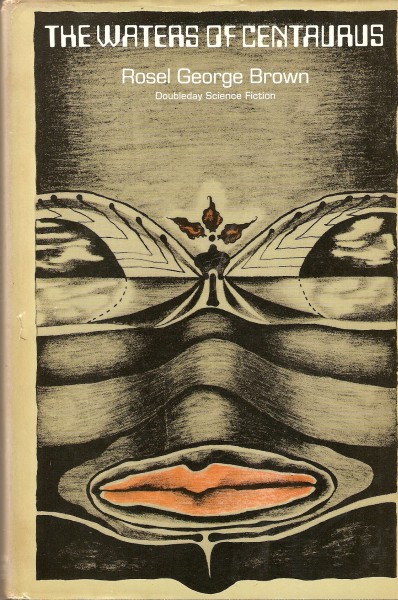
Cover art by Margo Herr
This is a direct sequel to Sibyl Sue Blue. My esteemed colleague Janice L. Newman gave that novel a glowing review. In fact, our own Journey Press saw fit to reprint it in a handsome new format.
Sibyl Sue Blue is back. She's a forty-year-old police detective and a widow with a teenage daughter. She's fond of cigars, gin, fancy clothes, and attractive men.
Continue reading [March 6, 1970] The Waters of Centaurus, And Chaos Died, and High Sorcery
[We've saved the best for last this month—one of these books is sure to be a pick for the Galactic Stars. Read on about this remarkable quartet of science fiction tales…]

by Jason Sacks
Time Trap, by Keith Laumer
Sometimes a back cover blurb sells a book. “ABE LINCOLN IN AFRICA?” the cover reads in breathless bold sans-serif type. “He was seen – and photographed – in a Tunisian bazaar.” Hooked yet? How about the mention on the cover of “an ancient Spanish galleon, fully crewed with ancient Spaniards, was taken in tow off Tampa by the Coast Guard…”
Yeah, you probably thought, take my 75¢ plus tax, because that’s a book I have to read. Especially if it’s scribed by the always delightful Keith Laumer, he of the wildly satirical Retief series. At the very least, Time Trap has to be readable, right?
Well, yes, Time Trap is readable, very much so in fact. I flew through its 143 pages in near lightspeed. But there’s just no there there. Time Trap is like a Big Mac: enjoyable at the time but utterly devoid of any nutrition.
Laumer’s latest is fun, sure, but maybe it’s too much fun. Because the novel is just too silly, too whimsical, too full of absurd wordplay and pointless tangents and the sense that Laumer was scripting little bits of this story between partying with friends and warming up for his next, more serious novel.
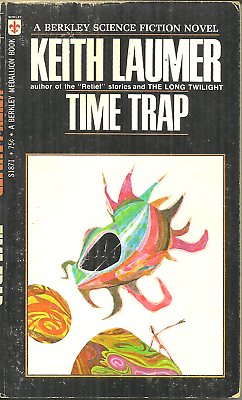
cover by Richard Powers

by Jason Sacks
War is on everybody’s minds these days as the controversies around the Vietnam War rage on.
Two new films, Patton and M*A*S*H, provide complex and nuanced views of war. These two films contrast strikingly, overlapping with some ideas, but dramatically far from each other with others.
The two films also present a complete contrast in look and feel. Patton has a traditional roadhouse production look and feel. But the film isn't stiff – it celebrates the quirkiness and depth of its lead character, making it a surprisingly complex film whose revolution rests with General Patton, himself. M*A*S*H focuses on the eccentricities of its lead characters but is surprisingly conservative in terms of gender roles and expectations. In its filming and style, however, M*A*S*H is like nothing we've seen before.
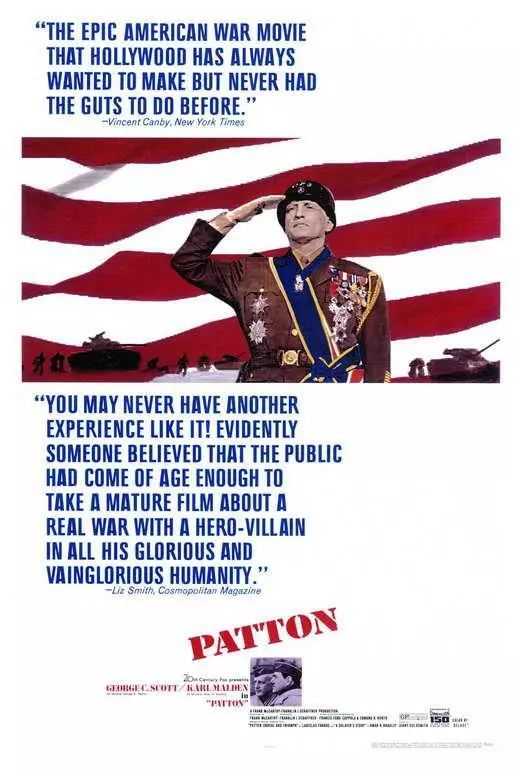
Patton, directed by Franklin J. Schaffner, stands as an epic portrayal of one of the most controversial and enigmatic military figures of World War II, General George S. Patton. The film not only delivers a stunning performance by George C. Scott but also delves into deeper themes that reflect the complexity of war and the man who seemingly thrived in it.
General George S. Patton, a larger-than-life figure with an unyielding belief in his destiny to lead and conquer, appears almost mythic in his determination and ferocity. Yet, within this portrayal, there's an underlying tragedy – Patton is depicted as a man out of his time, someone whose ideals and mannerisms belong to an era long past.
Patton’s character is deeply rooted in the ethos of classical warfare, where personal glory and valor were the hallmarks of a military hero. He draws inspiration from historical military figures and battles, often romanticizing the past and seeing himself as a continuation of a warrior tradition. This is evident from his astounding opening speech, where he declares, "Americans love a winner and will not tolerate a loser."
Throughout the film, Patton’s anachronistic views are at odds with the modern world. His reverence for discipline, his belief in reincarnation, and his disdain for weakness are portrayed as attributes of a bygone era. In a poignant scene, he compares himself to a gladiator, reflecting his belief that he is fighting not just a modern war but a timeless battle of wills.
Patton’s rigid adherence to these antiquated ideals often puts him at odds with his contemporaries. His confrontational and abrasive leadership style contrasts sharply with the more politically astute and strategic approaches of his peers. This tension culminates in moments where his actions, though tactically brilliant, are questioned for their diplomatic and ethical implications.
 General Patton at home in some Italian military ruins
General Patton at home in some Italian military ruins
The film does not shy away from showcasing the pro-war elements that define Patton's character. His speeches and actions glorify the warrior spirit and the thrill of battle. He revels in the chaos of war, viewing the battlefield as the ultimate test of character and leadership. Patton’s relentless pursuit of victory, his insistence on pushing his troops beyond their limits, and his disdain for those who falter, all underscore a pro-war narrative that valorizes aggression and tenacity.
A significant pro-war element is the depiction of Patton’s belief in destiny and divine guidance. He sees himself as an instrument of fate, chosen to lead and conquer. This almost messianic conviction drives him to extraordinary feats of leadership, inspiring his troops to achieve seemingly impossible victories. His charisma and unwavering confidence create a sense of inevitability about his success, reinforcing the idea that war, for him, is a stage where great men prove their worth.
 Director Schaffner with actor Scott
Director Schaffner with actor Scott
Yet, the film is not a one-dimensional glorification of war. Director Schaffner and writers Francis Ford Coppola and Edmund H. North present a nuanced view that also highlights the anti-war elements intrinsic to Patton’s story. The personal costs of Patton’s relentless drive for victory are evident in the toll it takes on those around him. His relationships are strained, his subordinates are pushed to their breaking points, and his superiors are often exasperated by his unyielding nature.
The film also critiques the destructive consequences of Patton’s actions. His obsession with glory and his impatience often leads to reckless decisions that jeopardize lives and missions. He is a man who hates what he sees as cowardice. He refuses to believe in battle fatigue. In fact, one of the most infamous incidents in Pattton’s career – and in this film – happens when he strikes a shell-shocked soldier. Victory is the crucial goal, no matter that a victory without human honor is disgraceful.
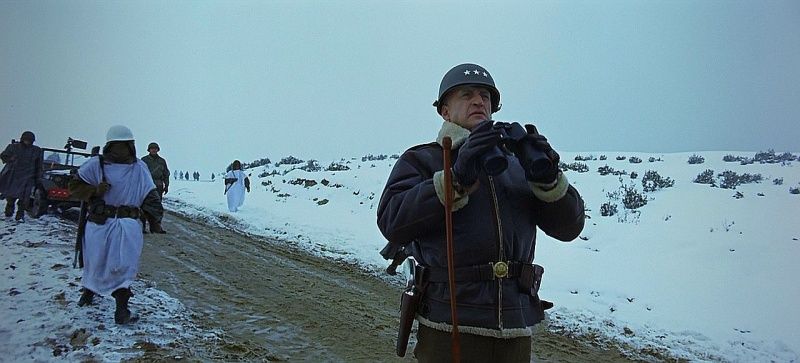 Patton has the long view of any military adventure.
Patton has the long view of any military adventure.
Moreover, the film portrays the political and moral dilemmas of warfare. Patton’s disdain for diplomacy and his confrontational attitude often clash with the broader strategic goals of the Allies. His near-dismissal for insubordination highlights the tensions between individual heroism and collective responsibility. The film underscores the notion that war is not just a series of battles but a complex interplay of politics, ethics, and human cost.
This film’s portrayal of Patton raises important questions about the nature of leadership and the morality of war. It invites viewers to consider whether greatness in war justifies the personal and ethical compromises that come with it. Patton’s character serves as a lens through which the audience can explore the dualities of war: its capacity to elevate and destroy, to inspire and to devastate.
Patton was filmed in a process called Dimension 150, similar to the old Todd A-O process which allowed extreme widescreen films (with a ratio of 2.25:1) to be shown with standard projectors. But as you know if you live in a big city, Patton is being marketed as a roadshow experience like The Sound of Music or Lawrence of Arabia.
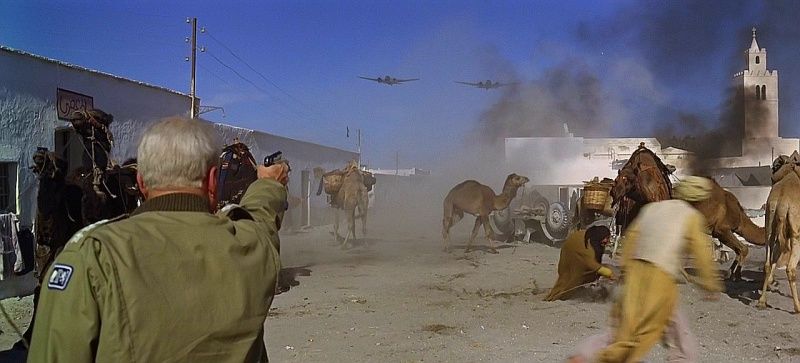 Just look at that glorious widescreen image!
Just look at that glorious widescreen image!
This results in Patton having a true epic feel: battle scenes feel titanic and powerful, filled from edge to edge with soldiers struggling through the mud or firing their rifles. It’s a powerful effect, though a dramatic contrast to our national character at the dawn of this decade. This approach reinforces the “great man” feeling of George Patton as a titan astride the fights he unleashes. It also helps to make him feel like a dinosaur.

M*A*S*H, on the other hand, feels as fresh as this week’s underground newspaper—irreverent and dismissive, full of tangents and wild moments. Patton may feel like a dinosaur, but Hawkeye, Trapper John, Painless Dentist, Nurse Hot Lips and the rest feel like people who just walked off the street in your home town.
There are acres of mud in Patton, but the world of M*A*S*H feels even muddier. Set in a military unit during the Korean War but clearly paralleling the Vietnam War, director Robert Altman delivers a film which feels like a revolution – even if its characters sometimes reinforce conservative values.
M*A*S*H has rightly been celebrated for its unconventional and groundbreaking approach to filmmaking. One of the most striking features is Altman’s use of overlapping dialogue and improvisation. This technique not only adds a layer of realism but also enhances the chaotic and unpredictable nature of life in a wartime medical unit. The characters speak over each other, conversations blend together, and the audience is plunged into the midst of the chaos. Patton allows characters to make speeches. M*A*S*H doesn’t want speeches.
A word here about the script: Ring Lardner Jr. is credited as the scriptwriter, adapting Richard Hooker’s novel. As I mentioned in a recent review, Lardner was one of the Hollywood Ten, a group of screenwriters who were blacklisted by the Hollywood system for their alleged involvement with the Communist Party. It’s an act of heroism to give Lardner work today, and a great sign of the changes to American politics. I do wonder how much of this film Lardner actually scripted – M*A*S*H feels thoroughly improvised – but I welcome seeing his name again.

Appropriately, M*A*S*H shuns the typical heroic combat narrative. Instead of glorifying war, M*A*S*H presents it as absurd and grotesque. The surgeons, led by the irreverent Hawkeye Pierce (Donald Sutherland) and Trapper John (Elliott Gould), cope with the horrors of war through dark humor, practical jokes, and general insubordination. The anti-establishment sentiment that runs through the film mirrors our own countercultural movements of the 1960s, making it resonant. Patton’s insubordination is internal; the insubordination in M*A*S*H is societal.
This insubordination makes M*A*S*H feel thoroughly contemporary. Everybody hates the army, its inflexibility, command structure, even its jeeps and the terrible movies it provides to the troops. Not even the intercom works as expected (the intercom also serves as a kind of Greek chorus for the film, an unexpected bit of meta-humor). I also found the insubordination to be thoroughly hilarious.
Altman’s use of non-linear storytelling and episodic structure further sets M*A*S*H apart. The film lacks a traditional plot, instead unfolding as a series of vignettes that illustrate the day-to-day lives of the characters. This approach allows for a more nuanced and multifaceted exploration of the war’s impact on individuals, eschewing the neat resolutions and moral clarity often found in war films.
 Trapper John and Hawkeye conning and confusing a helicopter pilot
Trapper John and Hawkeye conning and confusing a helicopter pilot
Individualism is at the center of everything Altman creates with his cast. None of these people are simple grunts manning their job. Instead, all the characters in the film, even those on the edges of the frame, feel like unique human beings. It even feels as if the movie could focus on those characters without sacrificing what makes this movie unique.
Despite its innovative approach, M*A*S*H is deeply conservative in its portrayal of the sexes. The film’s treatment of its female characters is troublesome. Women in M*A*S*H are largely depicted as objects of desire or sources of comic relief, reinforcing traditional gender stereotypes rather than challenging them.
Take, for example, the character of Major Margaret "Hot Lips" Houlihan, played by Sally Kellerman (Star Trek and Outer Limits). She is portrayed as a rigid, by-the-book officer who becomes the target of the male characters’ ridicule and pranks. The already-infamous shower scene, where her tent is lifted to expose her naked body to the entire camp, is a particularly glaring instance of the film’s sexist undertones. This scene is played for laughs, reducing Houlihan to a mere object of male amusement and stripping her of dignity.
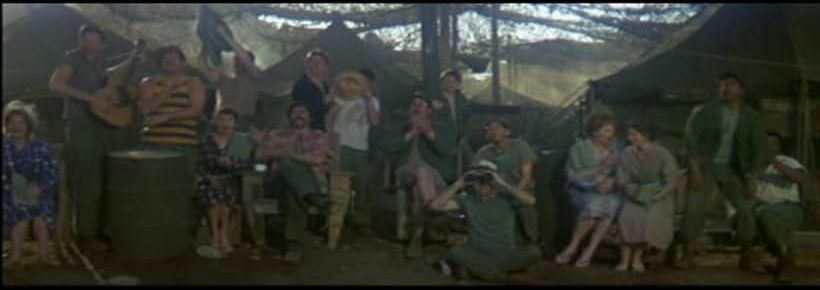 The entire camp of the MASH unit mocks Major Houlihan
The entire camp of the MASH unit mocks Major Houlihan
Furthermore, the film’s male characters frequently objectify and demean their female counterparts. Nurse Lt. Dish, for instance, is referred to more by her physical attributes than by her professional capabilities. The interactions between male and female characters often revolve around sexual innuendo or outright harassment, reflecting a chauvinistic attitude all too common in both the military and society then (and, of course, now).
This presents an interesting paradox for director Altman. Many reviewers rightly lauded Altman for his complex and nuanced portrayal of a female lead in his previous film, That Cold Day in the Park. M*A*S*H critiques many aspects of military life and the absurdity of war but does little to challenge the status quo regarding gender dynamics.
The only defense I can muster to that attack is to note how M*A*S*H shows a mostly male world at the hospital. Nearly all the officers are men, and all the injured are all men. Therefore, a male attitude prevailed at camp. M*A*S*H takes place in the early 1950s, when women had recently been sent back from factories and battlefields to the kitchen and motherhood. It was a conservative era in terms of gender roles, and male chauvinism was pervasive. Surely M*A*S*H would feel strange if women, even well-trained nurses, were treated as equals.
 Col. Blake is the only one who treats Houlihan as even slightly equal to him – but he is an ineffectual goof.
Col. Blake is the only one who treats Houlihan as even slightly equal to him – but he is an ineffectual goof.
The film’s humor, often at the expense of its female characters, underscores a broader societal acceptance of sexist behavior. In this sense, M*A*S*H may be revolutionary in its approach to storytelling and its anti-war message, but it remains entrenched in conservative views on gender roles.
M*A*S*H is a reminder of the limitations of our era’s progressive movement. While the film challenges many societal norms and offered a fresh perspective on war, it offers a discordant view in its representation of women, reflecting the broader struggles of the feminist movement as we enter the 1970s.
In fact, I adore M*A*S*H. I walked out of the theatre on an emotional high from seeing the film much like the high I get after seeing a great rock concert (I still think about that Blind Faith/Delaney & Bonnie show at the Seattle Center Coliseum last fall!) M*A*S*H feels like the revolution. It feels like the future. It feels like a new generation of film and I can’t wait to see what Robert Altman delivers next.
 Altman directing Gould and Sutherland
Altman directing Gould and Sutherland
But Patton was also a movie that really shook me, particularly the oddly naïve ways General Patton strove for glory. General Patton may have been a figure from my parents’ generation, but his attitudes and life philosophy were surprisingly nuanced in the hands of George C. Scott, Franklin J. Schaffner and the writers.
The characters in M*A*S*H could come of the streets of any American town. George Patton was one of those men who seemed like he could only succeed in war.
Both films provided me experiences I’ve never had before in a movie theatre.
Five stars for each.
[New to the Journey? Read this for a brief introduction!]
[New to the Journey? Read this for a brief introduction!]

by Gideon Marcus
The Long Loud Silence, by Wilson Tucker
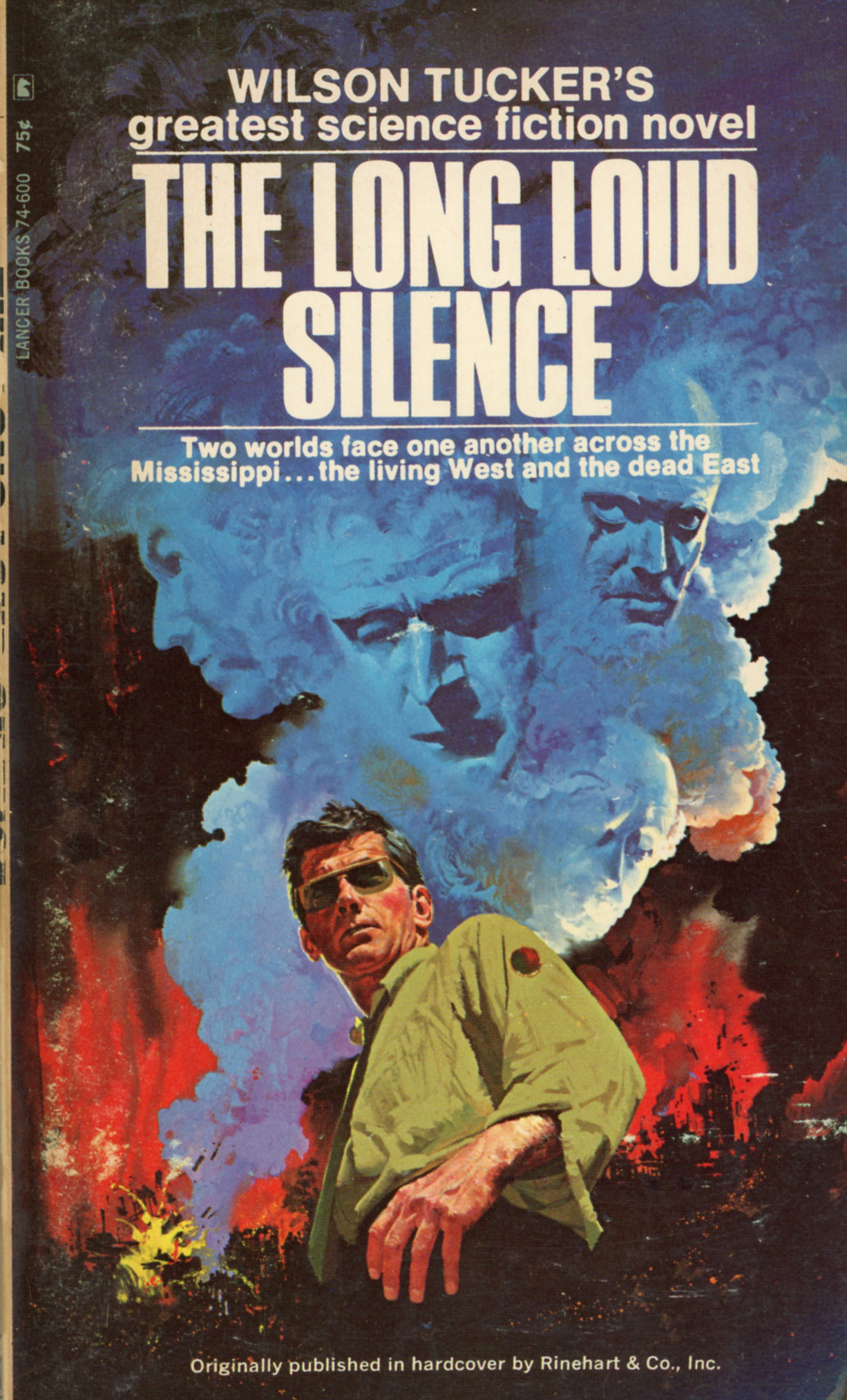
It's been a while since we've heard from Wilson Tucker, fan-turned-pro-but-still-very-much-a-fan. Hence, I was delighted to see that he had a new book out last month. Except, of course, it's not new at all, as I soon found out.

by Fiona Moore
Captain Nemo and the Underwater City
I had low expectations for Captain Nemo and the Underwater City, thinking it would be a bit of enjoyably fluffy escapism. For the most part this is true, but it does have a few things to recommend it beyond that.
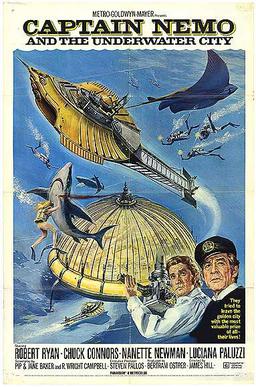
Poster for Captain Nemo and the Underwater City
The Nautilus rescues a small band of survivors from a shipwreck, and takes them to, yes, an underwater city founded by Captain Nemo (Robert Ryan) called Templemer (everyone pronounces it Temple-mere, which makes it sound like a small town in the Home Counties or possibly a plantation in the Old South). They include a plucky and intelligent widow (Nanette Newman) with a young son (Christopher Hartstone), a rugged-faced American senator (Chuck Connors), two comedy Cockney wide-boys (Bill Fraser and Kenneth Connor), a cute and suspiciously well-behaved kitten (name unknown), and an engineer who is clearly about to go over the edge of sanity (Allan Cuthbertson).
Templemer is a utopian community where food and drink and education are free, everyone lives their best lives, and gold is as common as steel is for us. At this point I rolled my eyes, expecting that the surface people would all decide that There’s No Place Like Home and plot to escape this perfectly decent hippie paradise; however, in fact, the newcomers are divided on that point, and their reasons for wanting to leave or stay are all in character and plausible.
 Nemo's guests are less than thrilled at their accommodation.
Nemo's guests are less than thrilled at their accommodation.
The movie explores the frequently-asked question of our time: whether it’s better to engage with the problems of society or just to tune in, turn on and drop out, building a better world outside instead. Nemo and his cohorts have definitely chosen the latter, while Senator Fraser’s reason for wanting to return to the surface is to do the former. The story explicitly takes place at the time of the American Civil War, and Nemo has undergone an ethnic shift to become an American. This gives the implication that Nemo is rejecting his own country’s troubles by retreating to Templemer and, consequently, inviting comparisons with the modern USA (and with Ryan himself, well known as a pacifist and an outspoken critic of the American government). Although the movie seems to want us to side with Senator Fraser, I personally remain unconvinced.
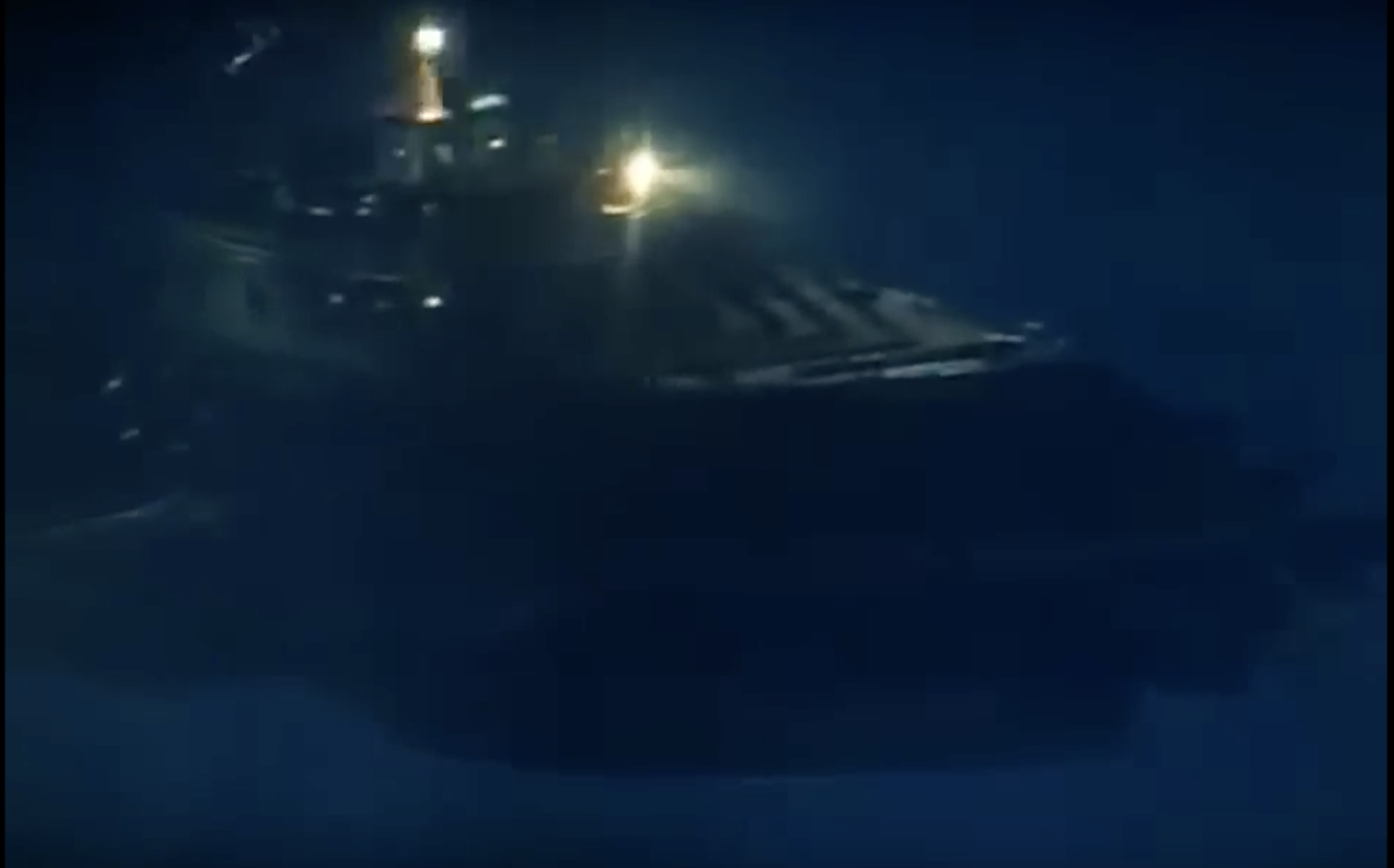 There's also some nice modelwork, even if it's often hard to see.
There's also some nice modelwork, even if it's often hard to see.
Of course, there are a lot of preposterous things that are overlooked or else are simply there to drive the story along. There’s a giant manta ray for our heroes to fight, which I suppose is a change from the usual giant squid. There’s only the briefest explanation of where Templemer’s population come from. The engineer’s mental collapse is so heavily telegraphed that I kept wishing someone would try and help the poor man rather than let him become another plot complication. There’s also a very long and very boring sequence where Nemo shows his guests around Templemer’s undersea farming setup, which contributes little to the story and isn’t particularly engaging and mostly seems to be there to show off the fact that MGM spent money for an expensive and complicated underwater shoot.
In short, I wouldn’t urge you to rush out and see it, but if it’s on at your local cinema and you have time to kill during the holidays, you could do worse. Two and a half stars.

by Jason Sacks
Marooned
What if the real heroes of NASA weren’t the astronauts but instead the ground crew? What if the astronauts were all either bland or jerks, while Mission Control were all brave, steadfast problem solvers to a man? What if a movie with those premises promised a thrilling story but delivered leaden action?
Imagine that movie, and you’ll get something like Marooned, a new film from director John Sturges seemingly released to capitalize on America’s fascination with the space program and our incipient worries about space failures. We might expect Marooned to be a thrilling and au courant film about man's perils in space. But Marooned is more concerned with the men on the ground than the men in space. That fact helps make for a slow trudge of a film.
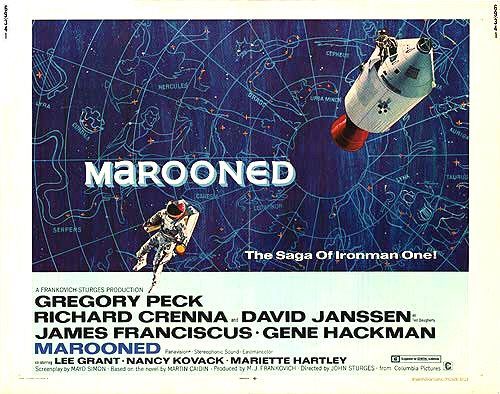
As the film begins, three astronauts played by Richard Crenna (The Real McCoys, Slattery's People, The Sand Pebbles), James Franciscus (The Investigators) and Gene Hackman (Hawaii, Bonny and Clyde) have completed their assignment to spend several months working in an orbiting laboratory. As the pilots begin their efforts to return to Earth, however, they find the thrusters malfunctioning on their rocket. It will take a heroic effort from the ground crew, led by Gregory Peck (needs no introduction) and David Janssen (The Fugitive), to return the astronauts to Earth. But will that dedicated crew succeed before oxygen runs out in the space capsule? And how will a hurricane at Cape Kennedy affect the rescue efforts?
It's an intriguing narrative for a movie (not to mention a book), and it's certainly very on-target for our country’s current obsessions. Marooned had the promise to be something pretty special; instead, it is a conservative, hide-bound, badly-acted failure.
Much of the film’s failure comes from an odd decision by the filmmakers: instead of focusing on the astronauts, the film spotlights their ground crew, particularly the efforts of their brave leader, Gregory Peck, to save the spacemen. In theory this could be a logical approach to the story which harnessed celebrity charisma to add seriousness to the rescue effort. Peck is a longstanding, proven screen presence. He gives the film a feeling of gravitas. But, come on, film fans: would you rather watch Gregory Peck struggle though rescue contingencies or spend more time with the astronauts trying to come up with plans? Without Cronkite (or even Chet and David) to spice things up, I can't imagine an audience is interested in watching the efforts of a bunch of white-shirt-and-tie men reading long lists of protocols off checklists, scene after tedious scene.
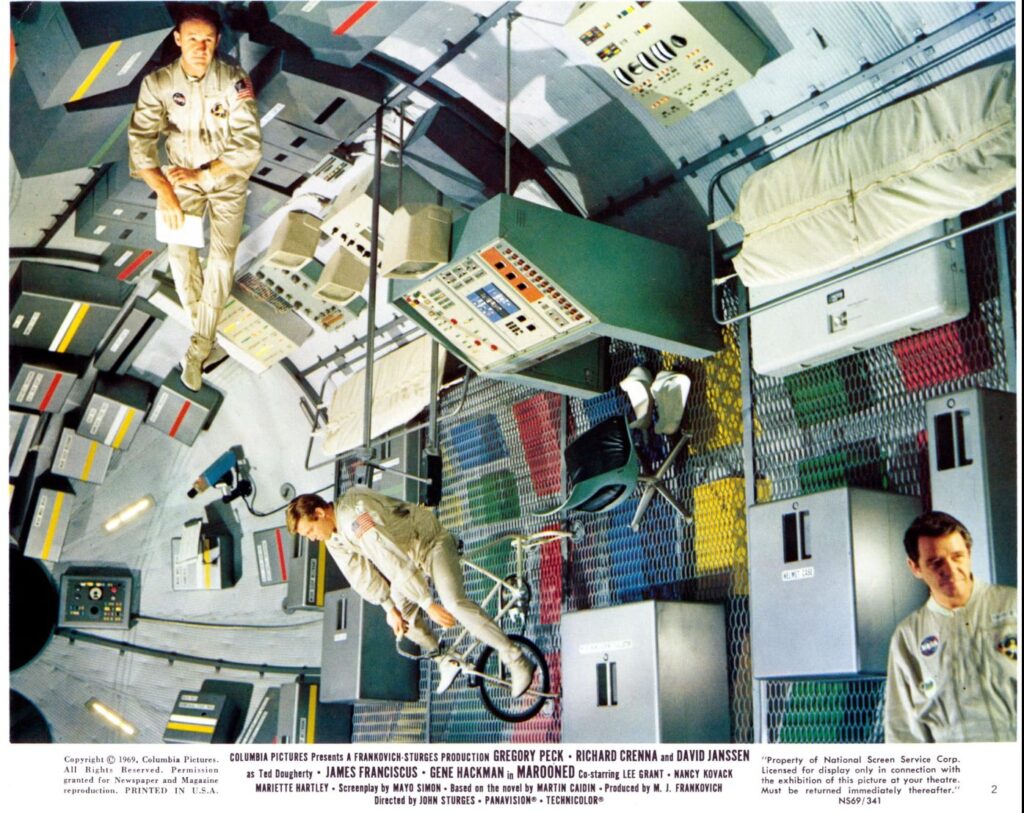
All that focus on protocols makes the film feel slow. But that very same slowness feels like a deliberate approach to the story. This is a workmanlike film which focuses on the amazing power of bureaucracy to solve complex problems. Solving these problems takes time, and it’s important to be able to be systematic and mark important items off a checklist. If only this movie had been cut to a crisp 90 minutes, the filmmakers’ gambit might have worked. Instead, Marooned is sluggish.
Peck seems to phone his role in. The intended gravitas from his role comes across more as torpor than as professionalism. Janssen and Franciscus bring their usual decent TV-level acting to their roles. But Hackman is especially badly selected for his role – his character, Buzz Lloyd, is impulsive and self-centered. Viewers grow tired of Buzz's histrionics and wonder how in the world someone like that made it through astronaut school. It's surprising to see Hackman perform so poorly after he recently delivered fine performances in Bonnie and Clyde and Downhill Racer, so hopefully this was just an anomaly. With his rugged good looks, Hackman looks more like a cop than an astronaut.
The film offers viewers a few small moments with the astronauts' wives. Those moments perhaps convey the most sense of the astronauts' peril, since the wives are allowed to actually emote. Veteran actresses Lee Grant (Peyton Place, In the Heat of the Night), Mariette Hartley (Star Trek: All Our Yesterdays) and Nancy Kovack (Star Trek: A Private Little War) have all done good work in the past. Here they are called upon to do little more than look concerned and show a little attitude. The actresses actually execute their assignments with aplomb. I especially enjoyed Kovack's frustrated resignation about the life she signed up for as the wife of an astronaut. She conveys a lot in small gestures and facial expressions.
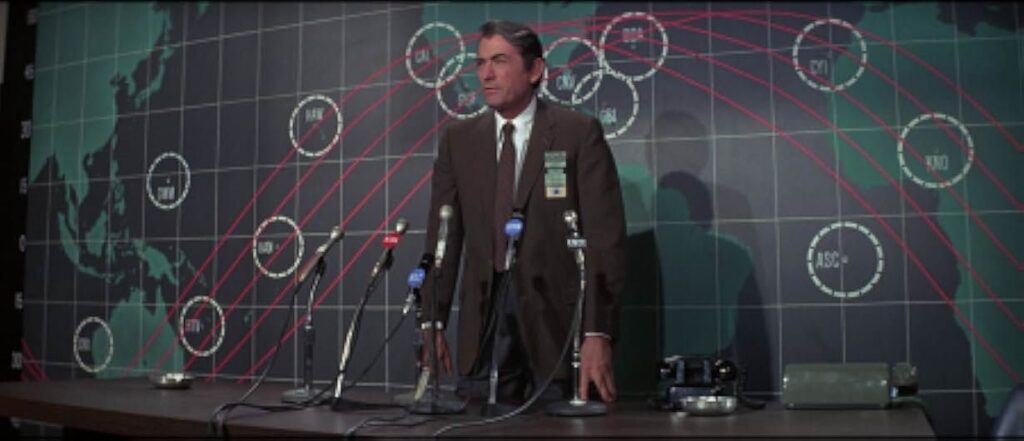
The ending, again slow, is genuinely captivating nonetheless, and takes a few surprising twists. I became very invested in this film in its last 20 minutes and wish we had more scenes like these. Though it was a bit hard to root for these dull men to be rescued, the attention to detail around astrophysics and international cooperation were stellar.
John Sturges is usually an excellent director of action movies – see Bad Day at Black Rock, The Magnificent Seven or The Great Escape. But he probably shouldn’t have journeyed into space with our boring astronauts. Marooned just never comes alive like The Magnficent Seven did: the characters never popped, the action never coruscated, and the direction lacked flash.

But there’s a deeper problem here as well. One of the reasons The Great Escape was such a smash hit was that many viewers could see themselves in the zealous Steve McQueen, endlessly looking to escape his prison life. McQueen’s Virgil Hilts felt like a counterculture hero on the run, not dissimilar to the characters in Easy Rider or Bonnie and Clyde. But Marooned is a conservative, conventional movie. Its message is to trust the government, pray for the best to happen, and follow rules. Marooned is a film for Nixon’s Silent Majority and feels woefully out of place next to this year’s big hit films like Butch Cassidy, Midnight Cowboy, and Goodbye, Columbus.
Two stars.